A recent post showing two of my vintage family quilts in all their torn and timeworn glory generated some very supportive, thoughtful reader comments. Instead of getting scolded for actually daring to use these aging, somewhat fragile quilts, I found kindred souls who believe like I do that stitched goods convey love and connection across generations.
(Have I mentioned lately how much I love you guys?)
Several people mentioned that seeing my falling-apart vintage quilts reminded them of older quilts they had stashed away, ones that also needed a little TLC and repair.
And some of you helped me see different aspects of this use/don’t use debate.
Says Cindy Sharp: “What is ‘historical value?’ You aren’t planning to sell the quilts that you use and love….and mending them makes you part of the historical chain that runs through them. I’d say repair the damage and continue to enjoy the love that those ladies poured into them.”
A reader using the name Accidentally Angela voted for repair and continued use, saying whatever was left for my girls to inherit would still make them happy.
“They will remember what a treasure they are because you have told them about your relatives making them. I think tangible objects make long lost relatives seem more real to our children too,” she writes.
And finally, another reader hits a very practical note when it comes to the use of family quilts. Says Kate: “Really, things only have value based on our emotional feeling about them. And no one will care if they are in a closet without being seen and having the stories told about them.”
For perspective from a modern quilter with a vintage itch, I reached out to Cincinnati area designer Heather Jones. She blogs at OliveandOllie.com and recently launched the Heather Jones Studio line of patterns. For all her modern bent as a designer, she also has a soft spot for vintage quilts, and has been collecting them for about 18-20 years. (The humble wool patchwork quilt at the beginning of this post is from Heather’s collection. It appears to have been made from a mish-mash of cut-up old suits and clothing.)
She comes by her vintage tastes honestly, her Great Aunt Ruth having had an antique store in a community about two hours away from where Heather was raised. The family visited often, and Heather says she loved wandering through the shop, seeing what old stuff was “new.”
“It was not a pristine store. You never knew what she would have. Every
time we would go, I would try to get something. I was always drawn to the
quilts she would have,” Heather recalls.
Besides her finds from Aunt Ruth’s store, Heather’s collection also includes quilts given to her by her stepmother, plus some amazing thrift store finds. And its those thrift-store quilts that really haunt her.
“They break my heart! You just think of the hours that were put into this piece and it ends up in a thrift store. I try to rescue them,” she says.
One of the notables in her collection is this Grandmother’s Flower Garden quilt, which she thinks dates to the 1930s.
Some of her faves in her collection have holes where they’ve been used, and she loves what those marks of use imply.
“To me, that’s what it’s about. I makes me happy to see that they were
used, that they were loved,” she says. “In the grand scheme of things,
that’s what they’re meant to be.”
When her stepmother gave her eight or nine quilts for the vintage collection, Heather decided she needed to document her collection in a series of weekly blog posts. (Start here to read the whole series.)
Where does she come down in the Mend & Use debate?
Well, with her background in fine arts history and a stint working at the Cincinnati Art Museum, she understands all about the tenuous life of textiles. It’s a conundrum, she says. Obviously you want to have these family pieces as long as possible, but you also want to be able to use them, and that use might shorten their lives.
And that’s when she thinks about her Great-Aunt Ollie, a quiltmaker from the hills of Kentucky, where quilts were made for warmth, not wall decor.
“I wish I could talk to her now that I have such an interest in these, to see what her thoughts were,” Heather says. “They made these to be used, not to be a non-functional object. They were made out of necessity.”
So, back to the debate. This won’t be a shock: I’ve decided I’m going to repair them and keep on using them. But the Tumbling Blocks might just grace the guest bed instead of the master bed, where Robin, our aging Wheaten Terrier, still occasionally leaps up for a little doggy shut-eye. After all, there are just some things a quilt shouldn’t have to endure.

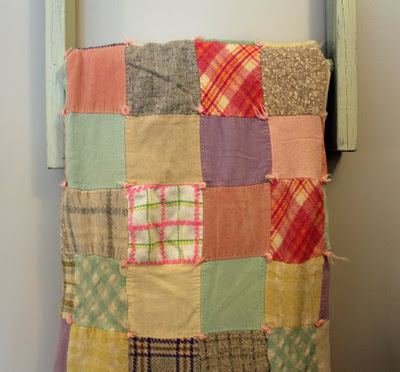


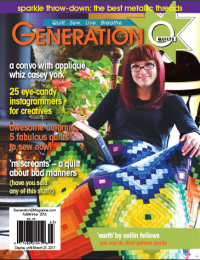
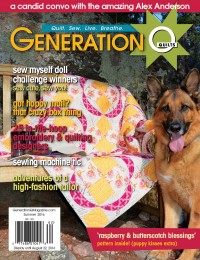

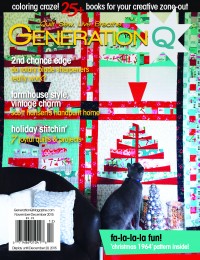
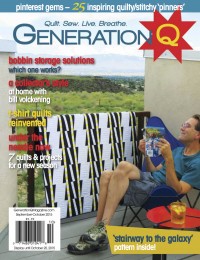
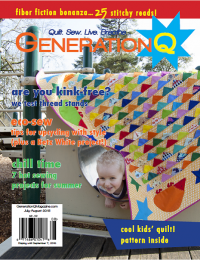
COMMENT #1
I’m a firm believer in using family heirlooms, whatever they are. As one of your commenters said, are you really planning on selling the quilts? I use my grandmother’s Limoge china every night for dinner and even put it in the dishwasher. It’s survived this treatment for more than 20 years and the flowers are still in place. What good would it be if it just stayed in the china cabinet? Same for quilts!
COMMENT #2
That sounds like a great compromise.
COMMENT #3
Ironically, I’ve been having this on-going debate with myself and others recently. A client sought me out and asked me to take three of his family’s quilts (all hand pieced and quilted) and make them larger to fit on a modern-day queen-size bed. One of them is just a quilt top, and he said someone in his family told him his great aunt pieced it in the 20s. Now, when someone with NO knowledge of quilts tells you this, and that someone told them it was from the 20s, you tend to shrug it off. I’ve had numerous people tell me that they have a quilt that they thought was 80 years old or so, and the fabrics are from the last 20 years, they were just faded, etc.
I got this gentleman’s quilts and gasped – it is an authentic 20s quilt top. The problem is, he wants about 30 inches added to it to make it larger to go on his bed. He and his wife only use their family’s quilts on their beds. As a quilter, I am so torn. The happiest part of me is thrilled to hear that someone USES their family’s quilts, because that’s what quilts are for. They aren’t just sitting in a box in an attic somewhere. But… the other part of me feels like I’m just going to RUIN this quilt by adding 20s repro fabric and solids to it. And am I going to totally devalue this quilt? He says even if it does take away some of the value of the quilt he still wants it done.
I’ve given him is options and in the end, if he wants it made larger so that he and his family can use it, I’m going to do as the customer requests.
COMMENT #4
Sounds like the perfect solution to me! The quilts are still being used and loved but not quite so energetically 🙂
COMMENT #5
I think that just the right way to use them Melissa!
I have the quilt my great-grandmother made for my Dad, who just turned 95 last month. He said that she gave it to him when he was about 9 years old, because she liked to know ‘what kind of person’ the child was going to be. She definitely made it to be used & it is mostly just a rag now, more holes than quilt. I need to dig it out & see if I can think of something to create with it.
He said that she called it a “Wheel of Fortune” quilt. Considering that when I was a kid, my Dad supported us between construction jobs by playing pinochle, I think she made him the exact right one!
COMMENT #6
I’m in full agreement that quilts are made to be used and loved. You might love and treasure the quilt and put it away so it will keep longer, and then the next generation doesn’t appreciate them and that’s how they end up in thrift stores. When you have them out and use them, the younger generation learns to treasure them, and maybe even desire to learn how to quilt.
I grew up in a German Mennonite community in Belize, and we made quilts for use, for necessity. Aunts, grandmother, cousins ect..would come together for sewing circles about once a month. I mostly remember these as a child when that was the opportunity for me to play with my cousins, but I did eventually participate some in the quilting before I moved from the community. I love to quilt and am super excited for anyone to learn to quilt no matter what age.
I sleep with a couple quilts every night, and bring them with me when I travel (if by road), or even when we go camping. Quilts are just the best!